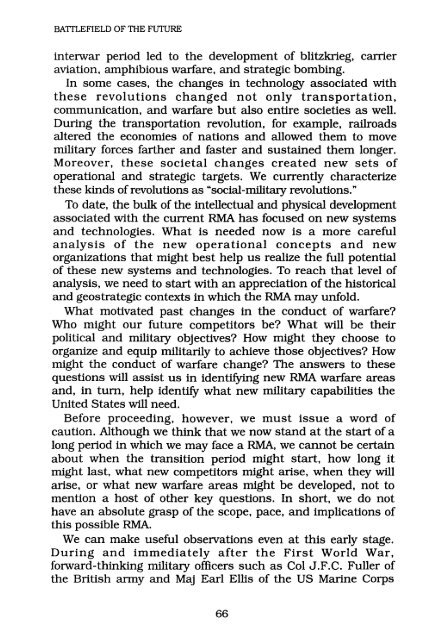BATTLEFIELD OF THE FUTURE
Battlefield of the Future - Air University Press
Battlefield of the Future - Air University Press
Create successful ePaper yourself
Turn your PDF publications into a flip-book with our unique Google optimized e-Paper software.
<strong>BATTLEFIELD</strong> <strong>OF</strong> <strong>THE</strong> <strong>FUTURE</strong><br />
interwar period led to the development of blitzkrieg, carrier<br />
aviation, amphibious warfare, and strategic bombing .<br />
In some cases, the changes in technology associated with<br />
these revolutions changed not only transportation,<br />
communication, and warfare but also entire societies as well .<br />
During the transportation revolution, for example, railroads<br />
altered the economies of nations and allowed them to move<br />
military forces farther and faster and sustained them longer .<br />
Moreover, these societal changes created new sets of<br />
operational and strategic targets . We currently characterize<br />
these kinds of revolutions as "social-military revolutions ."<br />
To date, the bulk of the intellectual and physical development<br />
associated with the current RMA has focused on new systems<br />
and technologies . What is needed now is a more careful<br />
analysis of the new operational concepts and new<br />
organizations that might best help us realize the full potential<br />
of these new systems and technologies . To reach that level of<br />
analysis, we need to start with an appreciation of the historical<br />
and geostrategic contexts in which the RMA may unfold .<br />
What motivated past changes in the conduct of warfare?<br />
Who might our future competitors be? What will be their<br />
political and military objectives? How might they choose to<br />
organize and equip militarily to achieve those objectives? How<br />
might the conduct of warfare change? The answers to these<br />
questions will assist us in identifying new RMA warfare areas<br />
and, in turn, help identify what new military capabilities the<br />
United States will need .<br />
Before proceeding, however, we must issue a word of<br />
caution . Although we think that we now stand at the start of a<br />
long period in which we may face a RMA, we cannot be certain<br />
about when the transition period might start, how long it<br />
might last, what new competitors might arise, when they will<br />
arise, or what new warfare areas might be developed, not to<br />
mention a host of other key questions . In short, we do not<br />
have an absolute grasp of the scope, pace, and implications of<br />
this possible RMA .<br />
We can make useful observations even at this early stage .<br />
During and immediately after the First World War,<br />
forward-thinking military officers such as Col J.F.C . Fuller of<br />
the British army and Maj Earl Ellis of the US Marine Corps<br />
66

















